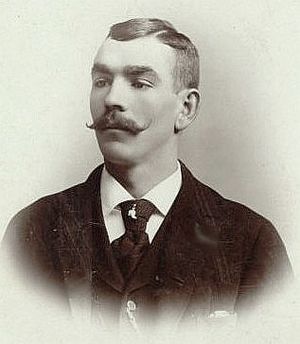Boyd's Law

Boyd's Law, or the Law of Alcoholic Effect, is a law of theoretical physics that was discovered in 1921 by Dr. Nathaniel Boyd. The law helps explain the effect alcohol has on a person or group's ability to party. It also explains the relationship between alcohol and money. Boyd's Law has been particularly useful not only to psychics students, but to students of many majors at any number of America's fine institutes of higher education. Boyd's Law has many practical benefits as well, in that it is a useful predictor of one's future ability to party. The discovery of Boyd's Law has been revolutionary to the field of physics and to the everyday lives of many college students. Nathaniel Boyd has received many awards for his discovery, both in life and afterwards, and is considered a hero to many.
Discovering the Law
Nathaniel Boyd was an American physicist and avid alcoholic. He would spend many of his weekends roughing it up in the town of Atlantic City, New Jersey and would often drink himself into either a temporary coma or into bankruptcy. On particularly good weekends he could accomplish both. On one weekend in 1921 Boyd was exceptionally intoxicated in the city of Montreal, Canada. He was there on a formal invitation from the International Guild of Extremely Hip Physicists for a conference on the effects of sunlight on the severity of one's hangover. Boyd was in attendance of a rather good physicists party when he suddenly realized that he was completely out of money, could not afford any more alcohol, and was not having a very smashing time. As the level of alcohol approached zero, he was forced to leave and go back to his hotel room. It was here that he began to think about the events that had transpired that night and thereafter began to formulate his theory of alcohol.
The Law
The theory that Boyd developed over the following weeks states, "Three variables are at play in any situation that involves gatherings of multiple adults in social contexts. The independent variables are the availability and level of alcohol, and the amount of money in one's possession, particularly pertaining to the ability to purchase alcohol, and finally the level of police, or cop, activity in the area. The dependent variable is the ability to party." As Boyd developed his theory, it also became clear to him that a simple mathematical proof could explain the theory and a variety of outcomes. It was also very good at predicting future occurrences and the likelihood of each. The formula is as follows:
P is the Party Index, A is the amount of alcohol available in terms of volume (in Liters), M is the money index, which describes the amount of money in American dollars available, and C is the Cop Index, which is comprised of the average number of cops that patrol the area in the span of a 24 hour period. What is interesting to note is that the number of individuals is irrelevant to the formula, as there is an underlying assumption that the current level of A is dependent on the number of individuals present, which therefore affects aggregate P. P will therefore be affected in relation to the number of individuals regardless of whether they are accounted for in the proof.
An example of the law being used to describe a very real scenario would be the following: It is a Friday night, you have 750 ml of alcohol, 100 dollars, and there are 10 cops patrolling per hour at that location. Your Party Index for that particular situation is 0.10075. Conversely, if there are multiple kegs present amounting to 3 liters of ethanol, there is an available fund of 300 dollars between all present allotted for further purchases of alcohol, and only 2 cops per hour patrol the area, the party index jumps to 1.515. It is important to note that it is assumed C will never equal zero since it is an average, it can however be an extremely low value, such as 0.0001. When both A and M reach zero, P also equals zero, thus the party ends.
filler
The Law in Everyday Life
Boyd's law is particularly effective at helping one predict how crazy a particular party will be. If one knows how many cops are present, they can use the formula to plan accordingly to see what levels of A and M are needed to make P off the hook. It can also be used to describe how pathetic an individual alcoholic's life is. For example, an alcoholic will have one liter of alcohol to consume in a single sitting on average, they will most likely have very little money left over to procure more booze, and therefore P will be extremely low.
College fraternities that are particularly good at partying make it no secret that they use this formula to their advantage. They know that having an ample supply of money allotted to alcohol, a good starting supply of booze, and a low level of cops around make for a very high level of P. This formula has even helped frats determine which locations around campus they should build their frat houses.
Needless to say, Boyd's Law has become a very important aspect of many people's lives and has widely been considered one of the most important scientific discoveries of the first quarter of the 20th Century.
The Implications
Dr. Manplayer's Alternative Theories
One of the most notable flaws of Boyd's Law is that it is entirely independent upon the number of girls within the room. Dr. Manplayer of the St. Augustine Institute of Alcohol Studies brought up this topic in his famous 1934 paper, "Why I think Dr. Boyd was Probably Lonely and Gay", where he goes on to bravely suggest that the fundamental Law of Alcoholic Effect should actually be altered to take into account his theory. Dr. Manplayer's theory was developed when he witnessed that despite the Party index being proportional to the allotment of Alcohol and Money, and inversely proportional to the Cop rate, it was also exponentially proportional to the number of girls in the room. It was this astounding effect that led Dr. Manplayer to call Dr. Boyd "a pussy."

Notice the sexy moustache and combover that Dr. "Nancy" Boyd was no doubt lacking.
This led to the Special Theory of Alcohol:
where G denotes the number of girls in the room at the time, and K denotes special constant. This special constant, K, troubled Dr. Manplayer for many a cool stiff pint, until he realized something, and in his drunken state of clarity called up his girlfriend and her hot sister who was working at the local police station.
Through much continued experimentation, he developed the General Theory of Alcohol:
The extra constants and are the constants which denotes the Girl Cop index and the Hourly Rate index. These constants are known as the 'Golden Constants' and refer to what Dr. Manplayer calls the 'Golden Limit', where if the girls bring the alcohol and are being paid to dress like cops, then the Party index sky-rockets.
Dr. Boyd's Rebuttal of Dr. Manplayer
Dr. Boyd was initially taken aback by the criticism of his law and spent many years soul-searching and questioning his scientific reasoning. After spending quite a few months traveling across Europe during 1935 attending many parties, Boyd came to realize that perhaps his law could be explained within the contexts that Dr. Manplayer raised in his essay. On his flight back to the United States of America Dr. Boyd began to write his response to Dr. Manplyer's theory, which would eventually become the famous essay entitled, "Why Dr. Manplayer is a Giant Twat. Also, I am not Gay."
In this paper, Boyd asserted that while the number of girls at the party could explain specific instances of rises in the Party index, generally aggregate P, which reflects the general level of all parties at any given time, will only reflect changes in the three variables presented initially by his Law of Alcoholic Effect. This led Boyd to postulate that perhaps two different theories could be developed; his Law of Alcoholic Effect was more global whereas Manplayer's Law was more local. Boyd also insulted Dr. Manplayer repeatedly in his paper and asserted at least 132 separate times that he was in fact heterosexual and very available.






